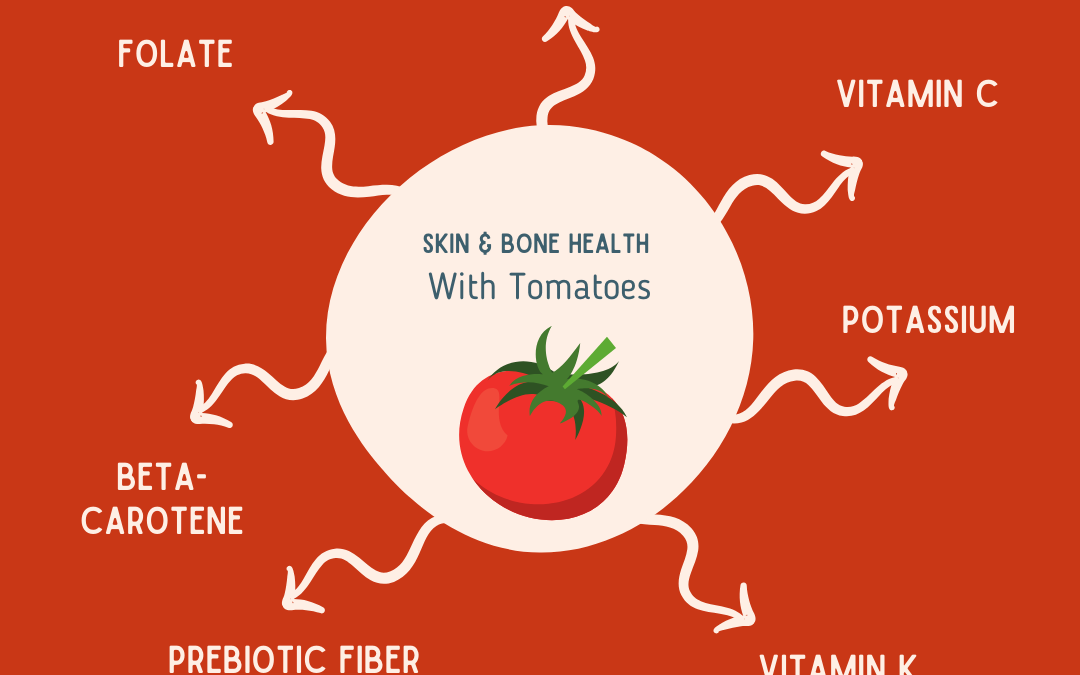
by Tomato Wellness | Jan 23, 2025 | Health
Nourish Skin, Strengthen Bones—With Tomatoes!
Introduction: The Foundation of Health – Skin and Bones
Healthy skin and bones are essential pillars of overall well-being. Our skin acts as the body’s first line of defense, shielding us from external harm while regulating temperature and preventing water loss.1,2 Meanwhile, strong bones provide the structural framework that supports our body, enabling movement, protecting internal organs, and storing essential minerals like calcium and phosphorus.3,4
 Maintaining the health of these two systems is critical. Healthy skin promotes confidence and prevents conditions like dryness, acne, or infections.1 Strong bones, on the other hand, reduce the risk of fractures and debilitating diseases like osteoporosis.3,4 Lifestyle choices, including diet, play a significant role in keeping these systems thriving, and one surprising ally in this journey is tomato products.
Maintaining the health of these two systems is critical. Healthy skin promotes confidence and prevents conditions like dryness, acne, or infections.1 Strong bones, on the other hand, reduce the risk of fractures and debilitating diseases like osteoporosis.3,4 Lifestyle choices, including diet, play a significant role in keeping these systems thriving, and one surprising ally in this journey is tomato products.
Nutrients in Tomato Products that Promote Skin and Bone Health
Tomatoes, whether fresh, canned, or in processed forms like sauces and pastes, are nutrient powerhouses that contribute to both skin and bone health. Here’s a closer look at their key components:
- Lycopene
Lycopene, a powerful antioxidant responsible for the red hue of tomatoes, is particularly beneficial for skin health. It helps neutralize free radicals that damage skin cells, reducing signs of aging and protecting against UV-induced harm.5,6 Studies suggest carotenoids, like lycopene, also support skin elasticity and hydration, and protect against DNA damage associated with skin cancer.5-7For bones, lycopene’s antioxidant properties help combat oxidative stress, which can lead to bone weakening. By reducing inflammation, lycopene contributes to maintaining bone density. (a,d) Additional studies show that lycopene may promote bone growth and inhibit breakdown of bone, helping to maintain strong bones.8
- Vitamin C
Tomato products are a rich source of vitamin C, a vital nutrient for collagen synthesis. Collagen is the main structural protein in skin and bones, promoting elasticity in the former and strength in the latter.1,9
- Vitamin K
Often overlooked, vitamin K plays a crucial role in bone mineralization. It helps regulate calcium deposition, ensuring that calcium is utilized effectively for bone strength.9 Tomato products like sauces and pastes retain this vital nutrient, making them an easy addition to a bone-healthy diet.
- Potassium
Tomatoes are packed with potassium, a mineral that helps maintain skin hydration and elasticity by balancing fluid levels in cells.5 For bones, potassium helps balance body pH, which helps reduce the excretion of calcium through urine, preserving bone mineral density.
- Beta-Carotene
Another antioxidant in tomatoes, beta-carotene, is converted into vitamin A in the body.4,6 This nutrient protects skin cells against damaging UV rays.1,2,7 In bone, beta-carotene has been associated with enhanced mineralization of bone and upregulation of bone formation pathways.4
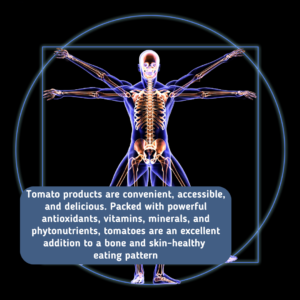
Additional Benefits of Processed Tomato Products for Skin and Bone Health
Processed tomato products are more than just a pantry staple; they can enhance the nutritional benefits of tomatoes, especially when it comes to promoting healthy skin and strong bones. Here’s why processed tomato products deserve special attention:
1. Increased Lycopene Bioavailability: The processing of tomatoes, such as cooking or canning, increases the bioavailability of lycopene. This means your body can absorb and use lycopene—a potent antioxidant—even more effectively.3,7 For skin, this results in greater protection against UV damage and oxidative stress, both of which contribute to aging and dullness. For bones, higher lycopene levels help combat oxidative stress and inflammation, which are linked to bone loss.
2. Prebiotic Support for the Skin and Bone Microbiomes: Some processed tomato products, particularly those with natural fibers, act as prebiotics. A healthy gut microbiome is linked to better nutrient absorption, including calcium and vitamin D, which are crucial for bone strength. A thriving microbiome also contributes to a balanced skin microbiome, reducing inflammation and improving skin health.1,10
3. Convenience for Consistency: Processed tomato products are quick and easy to use, encouraging regular consumption of these skin- and bone-supporting nutrients. Whether in a sauce, soup, or paste, they make it easier to include protective antioxidants and minerals in your daily meals, supporting consistent care for your skin and bones.
4. Affordable Year-Round Nutrition for Skin and Bones: Processed tomato products provide an economical and accessible way to nourish your skin and bones throughout the year. Unlike fresh tomatoes, which are seasonal and can be costly, canned or jarred options are budget-friendly and readily available.
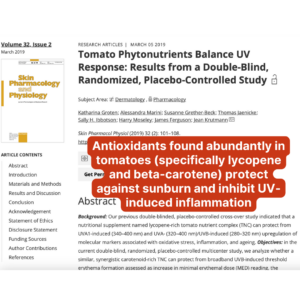
Conclusion: The Tomato Advantage
Tomato products are not just convenient and flavorful but also packed with nutrients that support the health of your skin and bones. By incorporating them into your diet, you’re nourishing your body with antioxidants, vitamins, and minerals that keep you looking and feeling your best. Whether it’s a vibrant tomato sauce or a comforting bowl of tomato soup, embracing the tomato’s versatility can be a simple yet effective step towards long-term wellness.
References:
- Woodby B, Penta K, Pecorelli A, Lila MA, Valacchi G. Skin Health from the Inside Out. Annu Rev Food Sci Technol. 2020 Mar 25;11:235-254. doi: 10.1146/annurev-food-032519-051722. Epub 2020 Jan 6. PMID: 31905017.
- Schagen SK, Zampeli VA, Makrantonaki E, Zouboulis CC. Discovering the link between nutrition and skin aging. Dermatoendocrinol. 2012;4(3):298-307. doi:10.4161/derm.22876
- Walallawita US, Wolber FM, Ziv-Gal A, Kruger MC, Heyes JA. Potential Role of Lycopene in the Prevention of Postmenopausal Bone Loss: Evidence from Molecular to Clinical Studies. Int J Mol Sci. 2020;21(19):7119. Published 2020 Sep 27. doi:10.3390/ijms21197119
- Faienza MF, Giardinelli S, Annicchiarico A, et al. Nutraceuticals and Functional Foods: A Comprehensive Review of Their Role in Bone Health. Int J Mol Sci. 2024;25(11):5873. Published 2024 May 28. doi:10.3390/ijms25115873
- Collins EJ, Bowyer C, Tsouza A, Chopra M. Tomatoes: An Extensive Review of the Associated Health Impacts of Tomatoes and Factors That Can Affect Their Cultivation. Biology (Basel). 2022;11(2):239. doi:10.3390/biology11020239
- Groten K, Marini A, Grether-Beck S, et al. Tomato Phytonutrients Balance UV Response: Results from a Double-Blind, Randomized, Placebo-Controlled Study. Skin Pharmacol Physiol. 2019;32(2):101-108. doi:10.1159/000497104
- Strouphauer E, Parke M, Perez-Sanchez A, Tantry E, Katta R. Functional Foods in Dermatology. Dermatol Pract Concept. 2023;13(4):e2023256. doi:10.5826/dpc.1304a256
- Costa-Rodrigues J, Fernandes MH, Pinho O, Monteiro PRR. Modulation of human osteoclastogenesis and osteoblastogenesis by lycopene. J Nutr Biochem. 2018 Jul;57:26-34. doi: 10.1016/j.jnutbio.2018.03.004. Epub 2018 Mar 15. PMID: 29655028.
- Campbell BJ. Calcium, Nutrition, and Bone Health. The American Academy of Orthopedic Surgeons. Reviewed August 2021. Accessed January 6, 2025. https://orthoinfo.aaos.org/en/staying-healthy/calcium-nutrition-and-bone-health/
- Hadadi N, Berweiler V, Wang H, Trajkovski M. Intestinal microbiota as a route for micronutrient bioavailability. Curr Opin Endocr Metab Res. 2021 Sep 4;20:100285. doi: 10.1016/j.coemr.2021.100285.
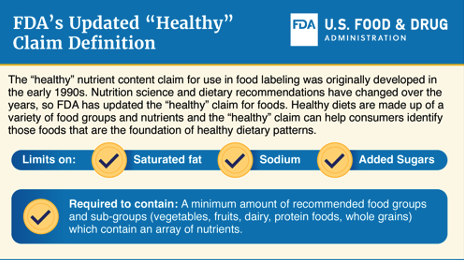
by Tomato Wellness | Jan 15, 2025 | News, Uncategorized
Are Tomato Products “Healthy”?
You may have read the headlines that the FDA just updated their definition of the term “healthy” as it relates to foods and beverages on store shelves. The FDA issued this final rule based on the latest health science available, so that consumers may easily identify foods in supermarkets that promote nutritious diets and ultimately help reduce the risks of chronic diseases, such as type 2 diabetes and heart disease. Improving nutrition is one of the best ways you can help prevent these diseases. In order for food products, like tomato products, to use the claim “healthy” on food labels they must follow specific criteria (see below) that were recently updated by the FDA. Since consumers rely on food labels to help guide them to making good choices, the use of “healthy” on food labels is a good thing! And given the new guidelines, when you see “healthy” on a food label you can rest assured that the food has met these new criteria for nutrition qualities in the food product that are healthful for you and your family. This new rule applies to a number of terms on labels, including “health, “healthful,” “healthfully,” “healthfulness,” “healthier,” “healthiest,” “healthily,” and “healthiness.” These types of claims on food labels are considered implied nutrient content claims, because they suggest that a food may provide health benefits to people who choose them. The good news is that many tomato products fit perfectly into the criteria for “healthy,” because they are food products packed with real tomatoes, rich in many nutrients that support wellness.
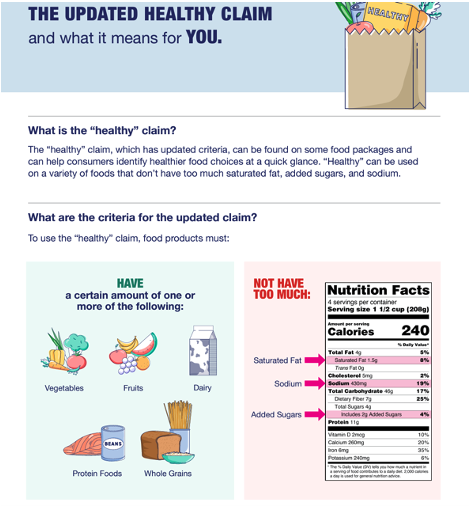
FDA Criteria for “Healthy” on Food Labels
It’s exciting that the new “healthy” guideline emphasizes nutrient-dense foods, such as vegetables. Many tomato products—based on whole tomatoes—automatically qualify as “healthy”.
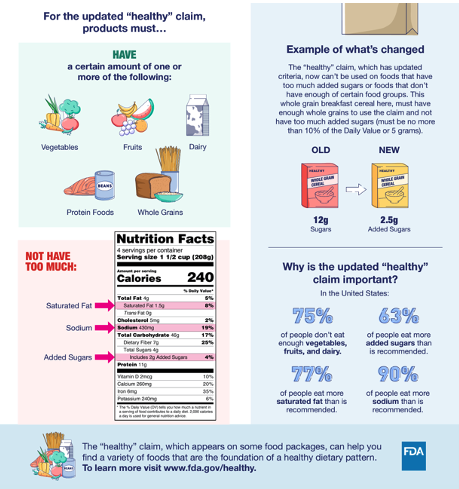
According to the new FDA guidelines, foods must meet the following criteria to be “healthy.”
- Vegetables, fruits, whole grains, fat-free and low-fat dairy, lean game meat, seafood, eggs, beans, peas, lentils, nuts, and seeds with no added ingredients except for water, automatically qualify for the “healthy” label. Many no added salt tomato products, such as canned diced, whole, or crushed tomatoes; tomato sauce, and tomato puree fit neatly into this category, as these foods are made with vegetables—delicious, wholesome tomatoes—with no other added ingredients other than water.
- Foods that provide the food group equivalent for a food group, meaning that a serving of the food product must deliver a full serving of the intended food group. In the case of tomato products, each ½ cup serving of canned diced, whole, or crushed tomatoes, tomato or marinara sauce, 100% tomato juice, and salsa delivers a full ½ cup equivalent of vegetables. And ¼ cup of tomato paste—which is a concentrated source of tomatoes—provides a full ½ cup serving of tomatoes. One cup of concentrated tomato soup provides a ¼ cup serving of tomatoes.
- Foods must meet the added sugar limit: 2% of the Daily Value (DV), which equals 1 gram of added sugar per serving. Many tomato products, such as canned diced, whole, or crushed tomatoes, tomato sauce, tomato paste, 100% tomato juice, and salsa are made without the addition of added sugars. You can read the Nutrition Facts labels to ensure your favorite tomato products achieve this level of added sugars.
- Foods must meet the sodium limit, which is 10% of the Daily Value (DV) or 230 mg per serving. Many tomato products, such as canned diced, whole, or crushed tomatoes, tomato sauce, and tomato puree, are below this threshold for sodium. You can look for no added salt products, or scan the nutrition facts label for sodium in your favorite tomato products—even those tomato products with added sodium may be below these levels.
- Foods must meet the saturated fat limit, which is 5% of the Daily Value (DV) or 1 gm per serving. Tomatoes and tomato products do not inherently contain appreciable levels of saturated fat. Most tomato products, including canned diced, whole, or crushed tomatoes, tomato sauce, and tomato puree—contain no saturated fat-containing ingredients, unless otherwise noted on labels.
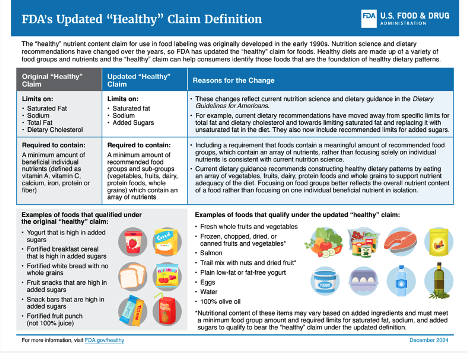
Bottomline on Healthy Tomato Products
Tomato products capture the essence of freshly harvested tomatoes. These delicious foods are a budget-friendly, accessible source of vegetables in your diet, and they can provide multiple nutrients, including vitamins A and C, potassium, iron, and fiber. In addition, they contain rich sources of the antioxidant compound lycopene, which is even more bioavailable in canned tomatoes compared to fresh. The nutrition profile of tomatoes—one of the most beloved vegetables in our diets—is linked with multiple health benefits, including reduced risks of cardiovascular disease and certain types of cancer. No wonder tomato products are a key part of many wholesome traditional diet patterns, including the Mediterranean diet and Latin American diet.
Sharon Palmer, MSFS, RDN
Learn more about these new “healthy” food guidelines here.
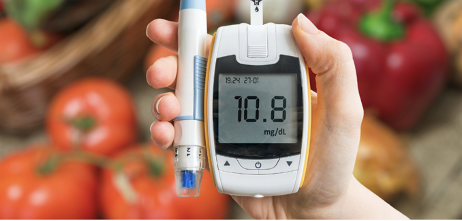
by Tomato Wellness | Jan 8, 2025 | Health
The Role of Tomato Products in Managing and Preventing Diabetes
Diabetes is a chronic condition that affects millions of people worldwide. It occurs when the body cannot properly regulate blood glucose (sugar) levels, leading to high blood sugar levels. There are two main types of diabetes: Type 1, where the body does not produce insulin, and Type 2, which is the most common form, where the body either does not produce enough insulin or becomes resistant to it.1 Understanding the role of diet, including the consumption of tomato products, can play a significant part in managing or even preventing diabetes.
Understanding Diabetes and Its Risk Factors
Diabetes is characterized by high blood sugar levels over a prolonged period. When the body is unable to produce or use insulin efficiently, glucose from food cannot enter the cells, leading to an accumulation of sugar in the bloodstream. Over time, this can cause various health complications, including heart disease, kidney damage, and nerve issues.1,2
Risk factors for Type 2 diabetes include1:
- Obesity: Excess fat, especially around the abdomen, increases the risk of insulin resistance.
- Age: The risk increases after age 45, but it can develop earlier.
- Family history: A family history of diabetes increases risk.
- Physical inactivity: A sedentary lifestyle is a key risk factor.
- Unhealthy diet: Diets high in processed foods, sugary drinks, and refined carbohydrates are linked to increased diabetes risk.
Lifestyle and Dietary Tips for Prevention
While genetics play a role in the development of diabetes, lifestyle choices can significantly reduce the risk. Here are some essential tips for preventing or managing diabetes1,3:
- Maintain a healthy weight: Losing even a small amount of weight can help improve insulin sensitivity and blood sugar control.
- Stay physically active: Regular exercise, such as walking, swimming, or cycling, can help regulate blood sugar levels and reduce insulin resistance.
- Eat a balanced, whole-foods-based diet: Focus on whole grains, lean proteins, vegetables, fruits, and healthy fats.
- Limit processed foods: Avoid sugary drinks, refined carbs, and highly processed snacks, which can spike blood sugar levels.
- Monitor carbohydrate intake: Opt for complex carbohydrates with a low glycemic index to maintain stable blood sugar levels.
Tomato Products: Nutrients and Constituents for Diabetes
Tomato products, such as fresh tomatoes, tomato sauce, and tomato paste, are rich in several nutrients that support overall health and may offer specific benefits for managing diabetes. Here’s a breakdown of how they can help:
- Low Glycemic Index: Tomatoes have a low glycemic index (GI), which means they do not cause rapid spikes in blood sugar levels. This makes them a good choice for people with diabetes.4
- Rich in Antioxidants: Tomatoes are an excellent source of antioxidants, particularly lycopene. Lycopene is a carotenoid that gives tomatoes their red color and is associated with numerous health benefits, including reduced inflammation and improved heart health. Research suggests that lycopene may help improve insulin sensitivity and blood glucose control, which is crucial for managing diabetes.2,5-7
- High in Vitamin C: Tomatoes are rich in vitamin C, which supports immune function and skin health. Vitamin C has also been linked to improved blood sugar control, as it may enhance insulin function.4,8
- Good Source of Fiber: Tomato products, especially when unpeeled, contain a good amount of dietary fiber. Fiber helps moderate the absorption of sugar into the bloodstream, preventing sharp spikes in blood glucose levels. It also promotes digestive health and can aid in weight management.4,7,9
- Potassium: Tomatoes are a good source of potassium, a mineral that helps regulate blood pressure. For people with diabetes, managing blood pressure is essential for reducing the risk of cardiovascular complications.7,9,10
- Anti-inflammatory Properties: Chronic inflammation is often linked to insulin resistance. The compounds in tomatoes, including lycopene and flavonoids, have anti-inflammatory effects that may help reduce the risk of developing Type 2 diabetes or its complications.2,4-7
- Magnesium: This mineral, present in tomatoes, plays a role in glucose metabolism. Adequate magnesium levels can improve insulin sensitivity and help maintain healthy blood sugar levels.7,9
How to Incorporate Tomato Products Into Your Diet
Including tomato products in your daily diet is easy and delicious. Here are some ideas for incorporating them into meals:
- Tomato-based sauces: Use tomato sauce or crushed tomatoes as a base for pasta, pizza, or stews.
- Salads: Add fresh tomatoes or roasted cherry tomatoes to salads for a burst of flavor and nutrients.
- Smoothies: Blend tomatoes with other vegetables and fruits to create a nutritious and refreshing smoothie.
- Salsas: Tomato salsa is a flavorful and low-calorie addition to many dishes, from grilled meats to roasted vegetables.
- Soups and stews: Tomato soup or vegetable stews are hearty meals that provide a good dose of vitamins and minerals.
Conclusion
Tomato products are a nutrient-dense food that offers multiple health benefits, particularly for people with diabetes or those at risk. Their low glycemic index, high antioxidant content, and rich array of vitamins and minerals make them an excellent choice for aiding in the management of blood sugar levels and promotion of overall health.2,4,7 By incorporating tomatoes into a balanced diet, you can take a proactive step toward preventing or managing diabetes while enjoying delicious, flavorful meals.
For the best results, combine the benefits of tomato products with other healthy lifestyle habits, including regular exercise, weight management, and mindful eating.1-3
References
- Cleveland Clinic. Diabetes. Reviewed February 17, 2023. Accessed December 17, 2024. https://my.clevelandclinic.org/health/diseases/7104-diabetes
- Leh HE, Lee LK. Lycopene: A Potent Antioxidant for the Amelioration of Type II Diabetes Mellitus. Molecules. 2022; 27(7):2335. https://doi.org/10.3390/molecules27072335
- Mayo Clinic. Diabetes diet: Create your healthy-eating plan. Published June 11, 2024. Accessed December 17, 2024. https://www.mayoclinic.org/diseases-conditions/diabetes/in-depth/diabetes-diet/art-20044295
- Collins EJ, Bowyer C, Tsouza A, Chopra M. Tomatoes: An Extensive Review of the Associated Health Impacts of Tomatoes and Factors That Can Affect Their Cultivation. Biology (Basel). 2022;11(2):239. doi:10.3390/biology11020239
- Leh HE, Mohd Sopian M, Abu Bakar MH, Lee LK. The role of lycopene for the amelioration of glycaemic status and peripheral antioxidant capacity among the Type II diabetes mellitus patients: A case-control study. Ann Med. 2021;53(1):1059-1065. doi: 10.1080/07853890.2021.1943515.
- Zeng Z, He W, Jia Z, Hao S. Lycopene Improves Insulin Sensitivity through Inhibition of STAT3/Srebp-1c-Mediated Lipid Accumulation and Inflammation in Mice fed a High-Fat Diet. Exp Clin Endocrinol Diabetes. Oct;125(9):610-617. doi: 10.1055/s-0043-101919
- Banihani SA. Tomato (Solanum lycopersicum L.) and type 2 diabetes. Int J of Food Properties. 2018;21(1):99–105. https://doi.org/10.1080/10942912.2018.1439959
- Younes S. The role of micronutrients on the treatment of diabetes. Human Nutrition & Metabolism. 2024;35:200238. https://doi.org/10.1016/j.hnm.2023.200238
- Campbell AP. DASH eating plan: An eating pattern for diabetes management. Diabetes Spectr. 2017 May;30(2):76-81. doi: 10.2337/ds16-0084.
- National Institutes of Health. Office of Dietary Supplements. Potassium. Updated June 2, 2022. Accessed December 18, 2024. https://ods.od.nih.gov/factsheets/Potassium-HealthProfessional/

 Maintaining the health of these two systems is critical. Healthy skin promotes confidence and prevents conditions like dryness, acne, or infections.1 Strong bones, on the other hand, reduce the risk of fractures and debilitating diseases like osteoporosis.3,4 Lifestyle choices, including diet, play a significant role in keeping these systems thriving, and one surprising ally in this journey is tomato products.
Maintaining the health of these two systems is critical. Healthy skin promotes confidence and prevents conditions like dryness, acne, or infections.1 Strong bones, on the other hand, reduce the risk of fractures and debilitating diseases like osteoporosis.3,4 Lifestyle choices, including diet, play a significant role in keeping these systems thriving, and one surprising ally in this journey is tomato products.






Recent Comments